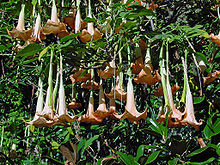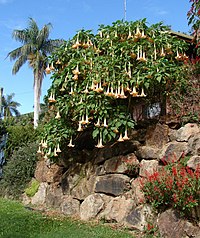339:
77:
312:
52:
33:
307:
species are native to the western part of South
America, originating from Guayaquil Basin and south of the Gulf of Guayaquil in Ecuador. They are usually found growing in flat areas at elevations up to 790 m (2,600 ft), but are also frequently cultivated at low elevations throughout the
356:
will grow well if placed in a partially shaded or fully lit position. The plants tend to wilt in hot temperatures, but quickly recover in the evening as their flowers begin to open. They thrive in very fertile soils and average humidity. Clones can easily be made from stem cuttings, and
281:. For this reason the two genera were commonly mistaken for one another. “It was not until the discovery of the New World that Brugmansias appeared in the documented floras and later in gardens of the Old World. Initially Brugmansias were grouped with Daturas by the famous botanist
552:
Abid Aqsa, Mushtaq Ahmad, Muhammad Zafar, Sadia Zafar, Mohamed Fawzy
Ramadan, Ashwaq T. Althobaiti, Shazia Sultana, Omer Kilic, Trobjon Makhkamov, Akramjon Yuldashev, Oybek Mamarakhimov, Khislat Khaydarov, Afat O. Mammadova, Komiljon Komilov, and Salman Majeed (December 2023).
551:
393:
will most likely cause symptoms of hallucinations, dry mouth, muscle weakness, increased blood pressure, increased pulse, fever, dilated pupils, temporary insanity, and paralysis, convulsions, difficulty breathing, illusions, paralysis, coma, loss of memory.
330:. It has long, narrow, fusiform berries that are up to 21 cm (8.3 in) in length. Brugmansia reproduce by the production of seeds. The major pollinators are thought to be various species of insects, though this has yet to be proven.
256:
is a bush or small tree reaching 3.0–4.9 m (10–16 ft) in height. It has an alternate insertion of elliptic/oblong leaves that are entire with smooth edges. One of the most prominent characteristics of
261:
is the presence of giant drooping flowers which hang upside down, which is where it gets its common name of Angel's
Trumpet. The flowers are the largest of all
352:
can withstand a wide range of temperatures including those that are slightly below freezing. A moderate frost will damage the plant in colder climates.
917:
596:
499:
296:
The different genera of the family
Solanaceae include many crop plants such as potatoes and tomatoes, as well as several other poisonous plants.
614:
811:
526:
293:
created a separate genus for
Brugmansia, but it was not until 1973 that Tom E. Lockwood created a final division between the two genera.
620:
850:
265:
at 300–510 mm (12–20 in) in length. They open first white, but then may age to turn peach, pink, apricot or remain white.
733:
937:
785:
746:
790:
927:
469:
555:"Foliar epidermal and trichome micromorphological diversity among poisonous plants and their taxonomic significance"
816:
932:
772:
675:
868:
699:
694:
751:
863:
613:"Angel's trumpet, Brugmansia Versicolor - Shrubs - Solanaceae garden." Gardening.eu - home. 7 May 2009
290:
76:
503:
942:
619:"Brugmansia Versicolor (PIER species info)." Hawaiian Ecosystems at Risk project (HEAR). 7 May 2009
435:
855:
530:
637:
590:
193:
829:
285:, who documented them in 1753 from a drawing and not from live plant material. In 1805, the
803:
720:
377:
that have toxic properties which affect the mind and body. Some of these alkaloids include
343:
8:
922:
559:
238:
56:
41:
842:
889:
625:"Brugmansia Versicolor Solanaceae Angel's Tears." EEB Greenhouse Home Page. 7 May 2009
71:
824:
707:
578:
465:
412:
374:
338:
894:
568:
430:
327:
712:
686:
114:
373:
is exceptionally poisonous if ingested in large quantities. It contains various
837:
660:
626:
101:
911:
798:
582:
421:
282:
61:
573:
554:
881:
361:
grow readily from viable seeds, however the plant will not self pollinate.
286:
311:
759:
669:
386:
382:
738:
389:. No matter if swallowed or inhaled, the flowers, leaves, and seeds of
226:
170:
160:
764:
150:
631:
876:
654:
378:
230:
140:
127:
777:
234:
725:
32:
369:
According to Dr. Russell, of North
Carolina State University,
277:
recognized, and they are very similar to their close relative
222:
88:
404:
242:
488:. Bot. Mus. Leafl. Harvard Univ. 23. (6): 273-284 (1973)
462:
Brugmansia and Datura: Angel's
Trumpets and Thorn Apples
464:. Buffalo, New York: Firefly Books. pp. 106–129.
529:. North Carolina State University. Archived from
527:"Poisonous Plants: Brugmansia spp. (Datura spp.)"
502:. University of Wisconsin-Madison. Archived from
229:, commonly known as “angel’s trumpets”. They are
909:
459:
460:Preissel, Ulrike; Preissel, Hans-Georg (2002).
436:10.2305/IUCN.UK.2014-1.RLTS.T38125A58908295.en
524:
237:. Since March 2014, they have been listed as
595:: CS1 maint: multiple names: authors list (
299:
455:
453:
273:There are currently 7 distinct species of
50:
31:
918:IUCN Red List extinct in the wild species
572:
434:
497:
337:
310:
450:
410:
910:
636:
635:
422:IUCN Red List of Threatened Species
326:is a hermaphrodite that reproduces
13:
14:
954:
545:
486:Generic recognition of Brugmansia
75:
869:urn:lsid:ipni.org:names:37444-2
607:
938:Garden plants of South America
518:
491:
478:
248:
1:
500:"Angel's Trumpet, Brugmansia"
397:
7:
364:
268:
10:
959:
333:
318:
291:Christiaan Hendrik Persoon
16:Species of flowering plant
644:
199:
192:
72:Scientific classification
70:
48:
39:
30:
23:
928:Endemic flora of Ecuador
300:Distribution and habitat
574:10.2478/fhort-2023-0019
933:Near threatened plants
346:
315:
676:Brugmansia versicolor
646:Brugmansia versicolor
429:: e.T38125A58908295.
415:Brugmansia versicolor
371:Brugmansia versicolor
341:
324:Brugmansia versicolor
314:
254:Brugmansia versicolor
218:Brugmansia versicolor
203:Brugmansia versicolor
25:Brugmansia versicolor
344:Pashupatinath Temple
560:Folia Horticulturae
239:Extinct in the Wild
57:Extinct in the Wild
42:Conservation status
525:Russell, Alice B.
484:Lockwood TE. 1973
347:
316:
185:B. versicolor
905:
904:
825:Open Tree of Life
638:Taxon identifiers
375:tropane alkaloids
214:
213:
65:
950:
943:Perennial plants
898:
897:
885:
884:
872:
871:
859:
858:
846:
845:
833:
832:
820:
819:
807:
806:
794:
793:
781:
780:
768:
767:
755:
754:
742:
741:
729:
728:
716:
715:
703:
702:
690:
689:
680:
679:
678:
665:
664:
663:
633:
632:
601:
600:
594:
586:
576:
549:
543:
542:
540:
538:
522:
516:
515:
513:
511:
495:
489:
482:
476:
475:
457:
448:
447:
445:
443:
438:
411:Hay, A. (2014).
408:
221:is a species of
205:
80:
79:
59:
54:
53:
35:
21:
20:
958:
957:
953:
952:
951:
949:
948:
947:
908:
907:
906:
901:
893:
888:
880:
875:
867:
862:
854:
849:
841:
836:
828:
823:
815:
810:
802:
797:
789:
784:
776:
771:
763:
758:
750:
745:
737:
732:
724:
719:
711:
706:
698:
693:
685:
683:
674:
673:
668:
659:
658:
653:
640:
610:
605:
604:
588:
587:
550:
546:
536:
534:
523:
519:
509:
507:
496:
492:
483:
479:
472:
458:
451:
441:
439:
409:
405:
400:
367:
336:
321:
302:
271:
251:
210:
207:
201:
188:
74:
66:
55:
51:
44:
17:
12:
11:
5:
956:
946:
945:
940:
935:
930:
925:
920:
903:
902:
900:
899:
895:wfo-0001019785
886:
873:
860:
847:
834:
821:
808:
795:
782:
769:
756:
743:
730:
717:
704:
691:
681:
666:
650:
648:
642:
641:
630:
629:
623:
617:
609:
606:
603:
602:
567:(2): 243–274.
544:
517:
490:
477:
470:
449:
402:
401:
399:
396:
366:
363:
342:Brugmansia in
335:
332:
320:
317:
301:
298:
270:
267:
250:
247:
225:in the family
212:
211:
208:
197:
196:
190:
189:
182:
180:
176:
175:
168:
164:
163:
158:
154:
153:
148:
144:
143:
138:
131:
130:
125:
118:
117:
112:
105:
104:
99:
92:
91:
86:
82:
81:
68:
67:
49:
46:
45:
40:
37:
36:
28:
27:
15:
9:
6:
4:
3:
2:
955:
944:
941:
939:
936:
934:
931:
929:
926:
924:
921:
919:
916:
915:
913:
896:
891:
887:
883:
878:
874:
870:
865:
861:
857:
852:
848:
844:
839:
835:
831:
826:
822:
818:
813:
809:
805:
800:
796:
792:
787:
783:
779:
774:
770:
766:
761:
757:
753:
748:
744:
740:
735:
731:
727:
722:
718:
714:
709:
705:
701:
696:
692:
688:
682:
677:
671:
667:
662:
656:
652:
651:
649:
647:
643:
639:
634:
627:
624:
621:
618:
615:
612:
611:
598:
592:
584:
580:
575:
570:
566:
562:
561:
556:
548:
533:on 2011-05-14
532:
528:
521:
506:on 2023-05-31
505:
501:
498:Mahr, Susan.
494:
487:
481:
473:
471:1-55209-598-3
467:
463:
456:
454:
437:
432:
428:
424:
423:
418:
416:
407:
403:
395:
392:
388:
384:
380:
376:
372:
362:
360:
355:
351:
345:
340:
331:
329:
325:
313:
309:
306:
297:
294:
292:
288:
287:South African
284:
283:Carl Linnaeus
280:
276:
266:
264:
260:
259:B. versicolor
255:
246:
244:
240:
236:
232:
228:
224:
220:
219:
206:
204:
198:
195:
194:Binomial name
191:
187:
186:
181:
178:
177:
174:
173:
169:
166:
165:
162:
159:
156:
155:
152:
149:
146:
145:
142:
139:
136:
133:
132:
129:
126:
123:
120:
119:
116:
113:
110:
107:
106:
103:
102:Tracheophytes
100:
97:
94:
93:
90:
87:
84:
83:
78:
73:
69:
63:
58:
47:
43:
38:
34:
29:
26:
22:
19:
645:
608:Bibliography
591:cite journal
564:
558:
547:
535:. Retrieved
531:the original
520:
508:. Retrieved
504:the original
493:
485:
480:
461:
440:. Retrieved
426:
420:
414:
406:
390:
370:
368:
358:
353:
349:
348:
323:
322:
304:
303:
295:
278:
274:
272:
262:
258:
253:
252:
217:
216:
215:
202:
200:
184:
183:
171:
134:
121:
108:
95:
24:
18:
843:kew-2684020
760:iNaturalist
670:Wikispecies
537:24 February
442:17 November
387:hyoscyamine
383:scopolamine
328:perennially
289:taxonomist
249:Description
115:Angiosperms
923:Brugmansia
912:Categories
838:Plant List
510:19 October
398:References
391:Brugmansia
359:Brugmansia
354:Brugmansia
350:Brugmansia
305:Brugmansia
275:Brugmansia
263:Brugmansia
227:Solanaceae
172:Brugmansia
161:Solanaceae
583:2083-5965
308:tropics.
179:Species:
151:Solanales
85:Kingdom:
882:29604525
877:Tropicos
661:Q2706379
655:Wikidata
379:atropine
365:Toxicity
269:Taxonomy
157:Family:
141:Asterids
128:Eudicots
62:IUCN 3.1
778:37444-2
739:5581019
726:5694321
334:Culture
319:Ecology
241:by the
235:Ecuador
231:endemic
209:Lagerh.
167:Genus:
147:Order:
89:Plantae
60: (
851:PLANTS
830:742110
817:301915
791:821232
765:189943
752:102424
700:773788
687:234753
684:APDB:
581:
468:
385:, and
279:Datura
856:BRVE9
804:38125
223:plant
135:Clade
122:Clade
109:Clade
96:Clade
864:POWO
812:NCBI
799:IUCN
786:ITIS
773:IPNI
747:GRIN
734:GBIF
713:NFDG
695:BOLD
597:link
579:ISSN
539:2011
512:2023
466:ISBN
444:2021
427:2014
243:IUCN
890:WFO
721:EoL
708:CoL
569:doi
431:doi
233:to
914::
892::
879::
866::
853::
840::
827::
814::
801::
788::
775::
762::
749::
736::
723::
710::
697::
672::
657::
593:}}
589:{{
577:.
565:35
563:.
557:.
452:^
425:.
419:.
381:,
245:.
137::
124::
111::
98::
628:.
622:.
616:.
599:)
585:.
571::
541:.
514:.
474:.
446:.
433::
417:"
413:"
64:)
Text is available under the Creative Commons Attribution-ShareAlike License. Additional terms may apply.


